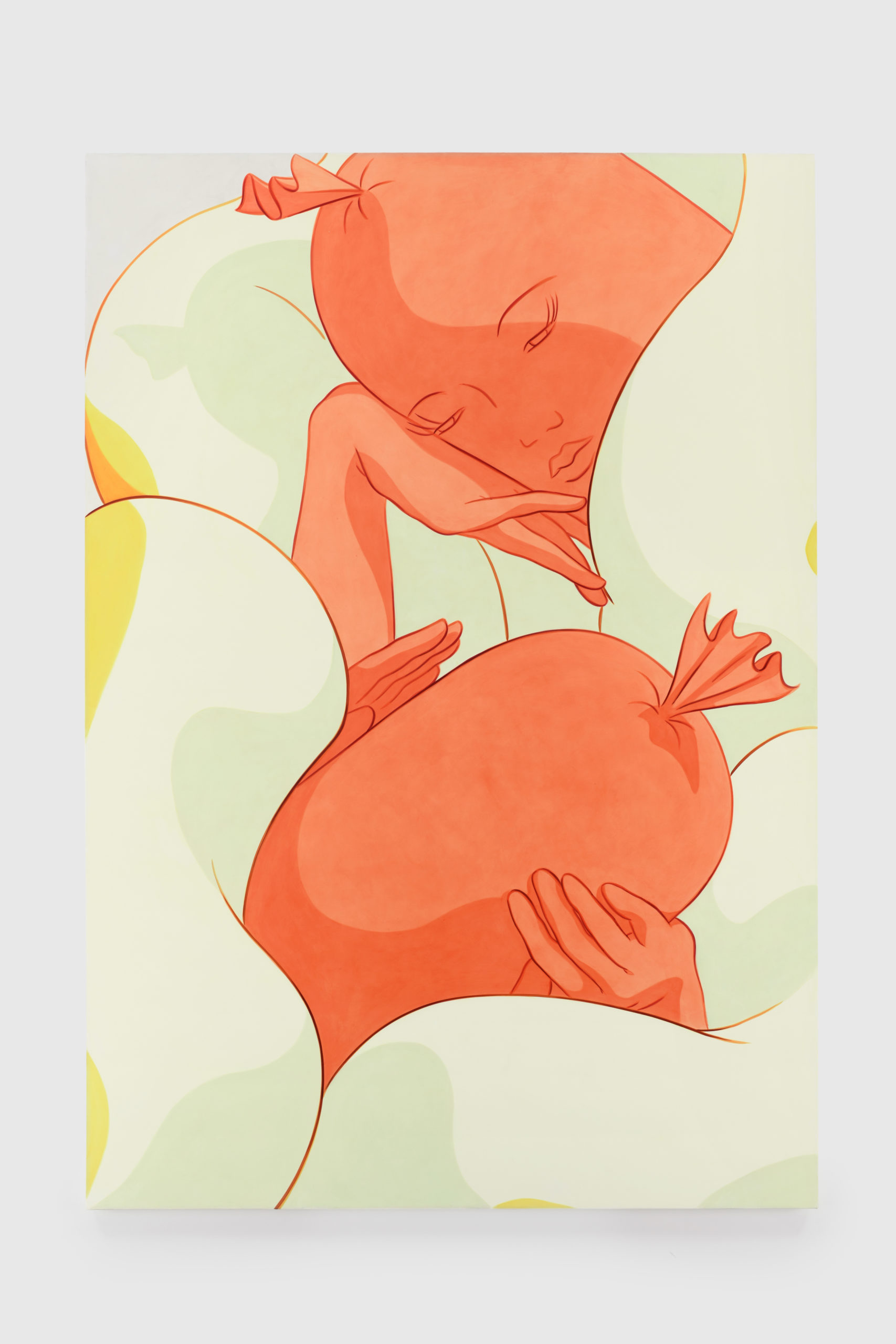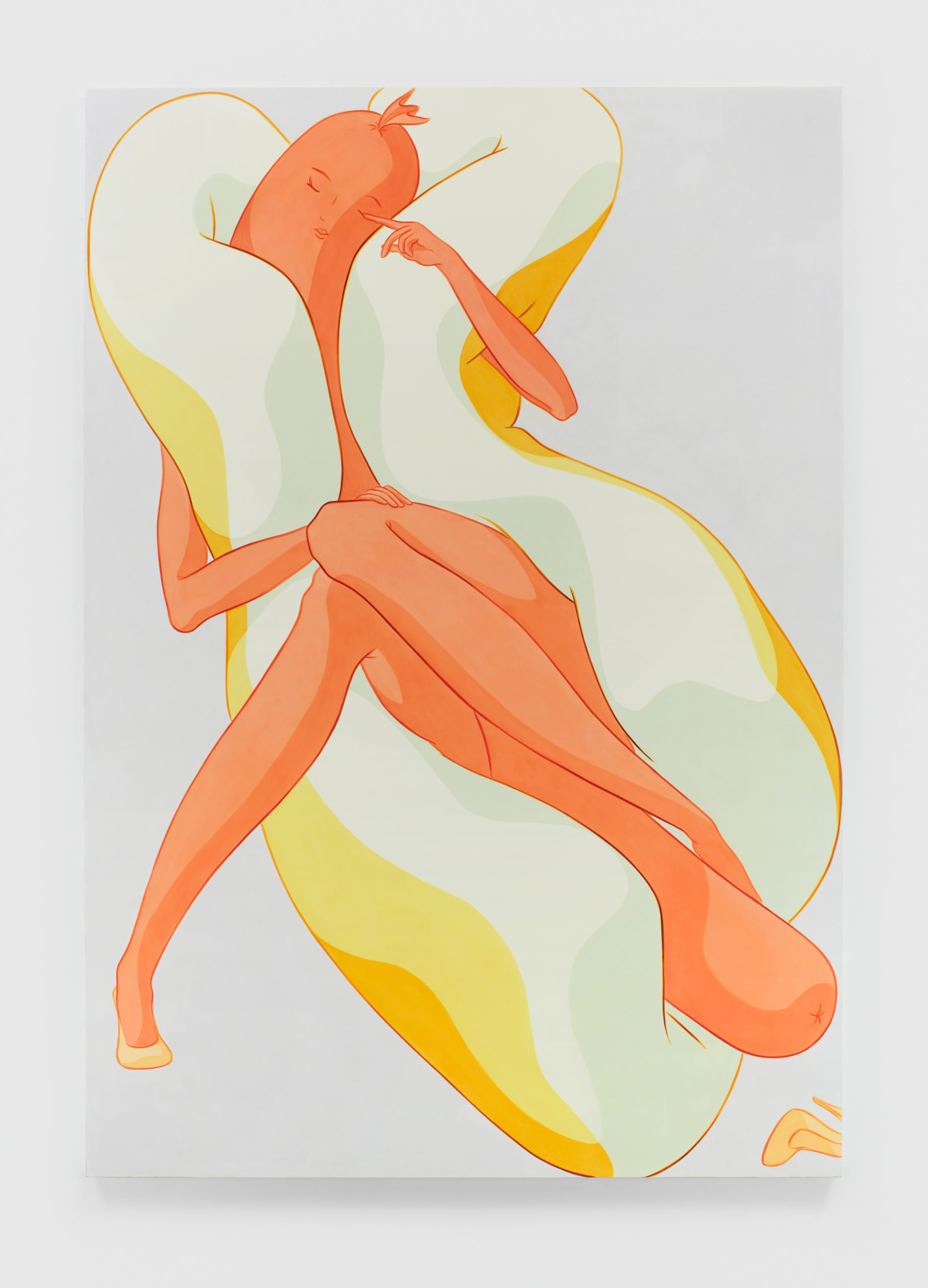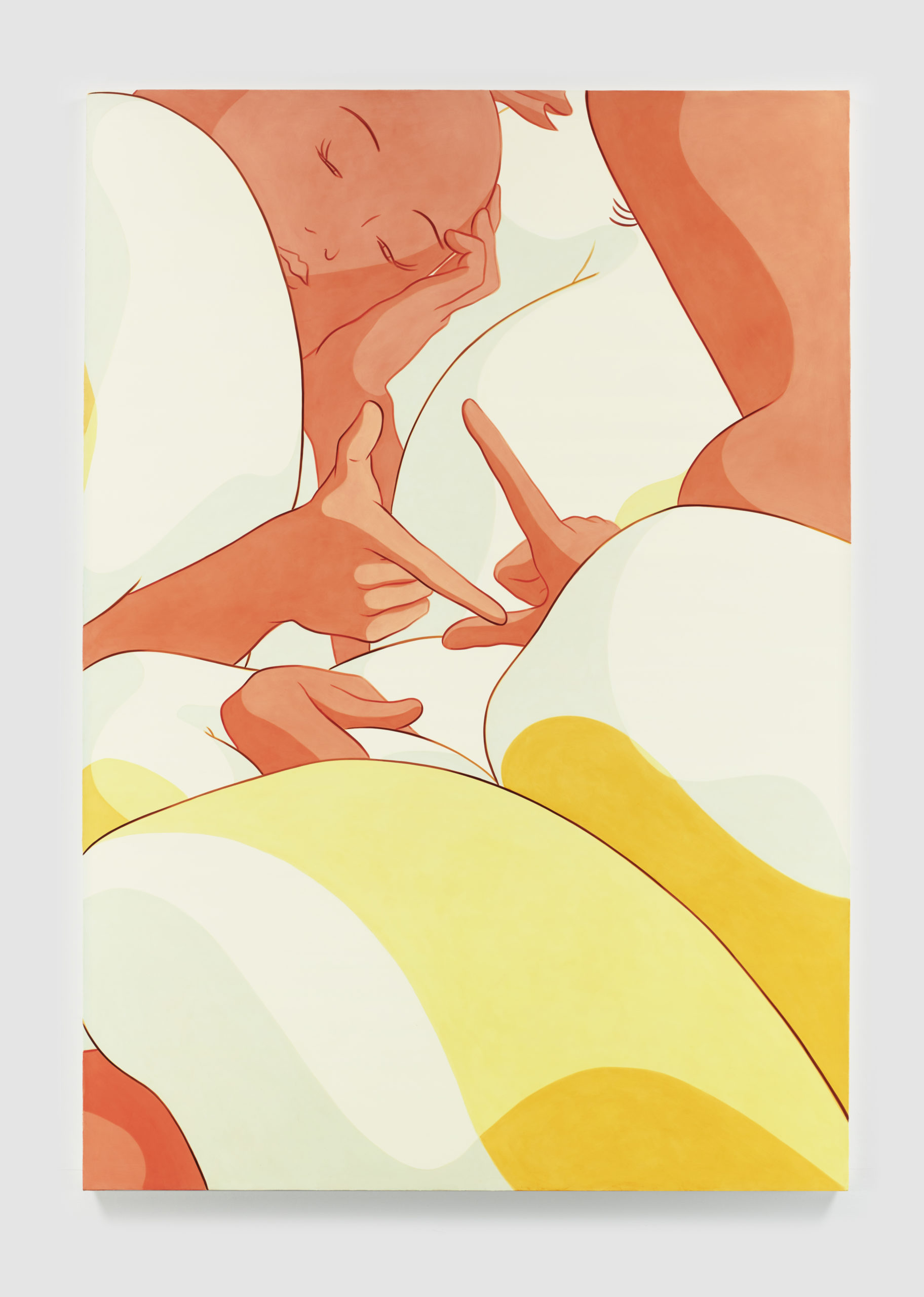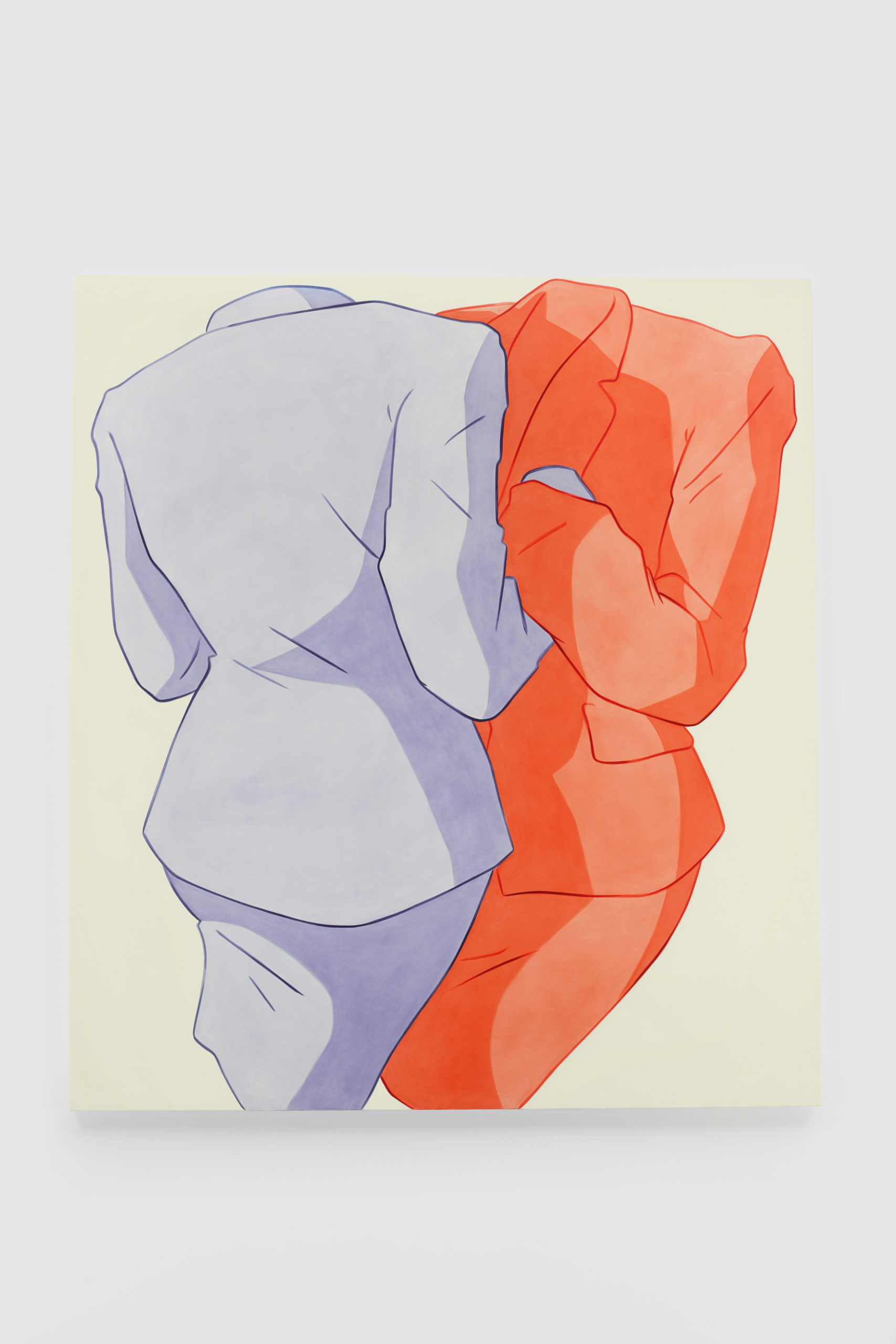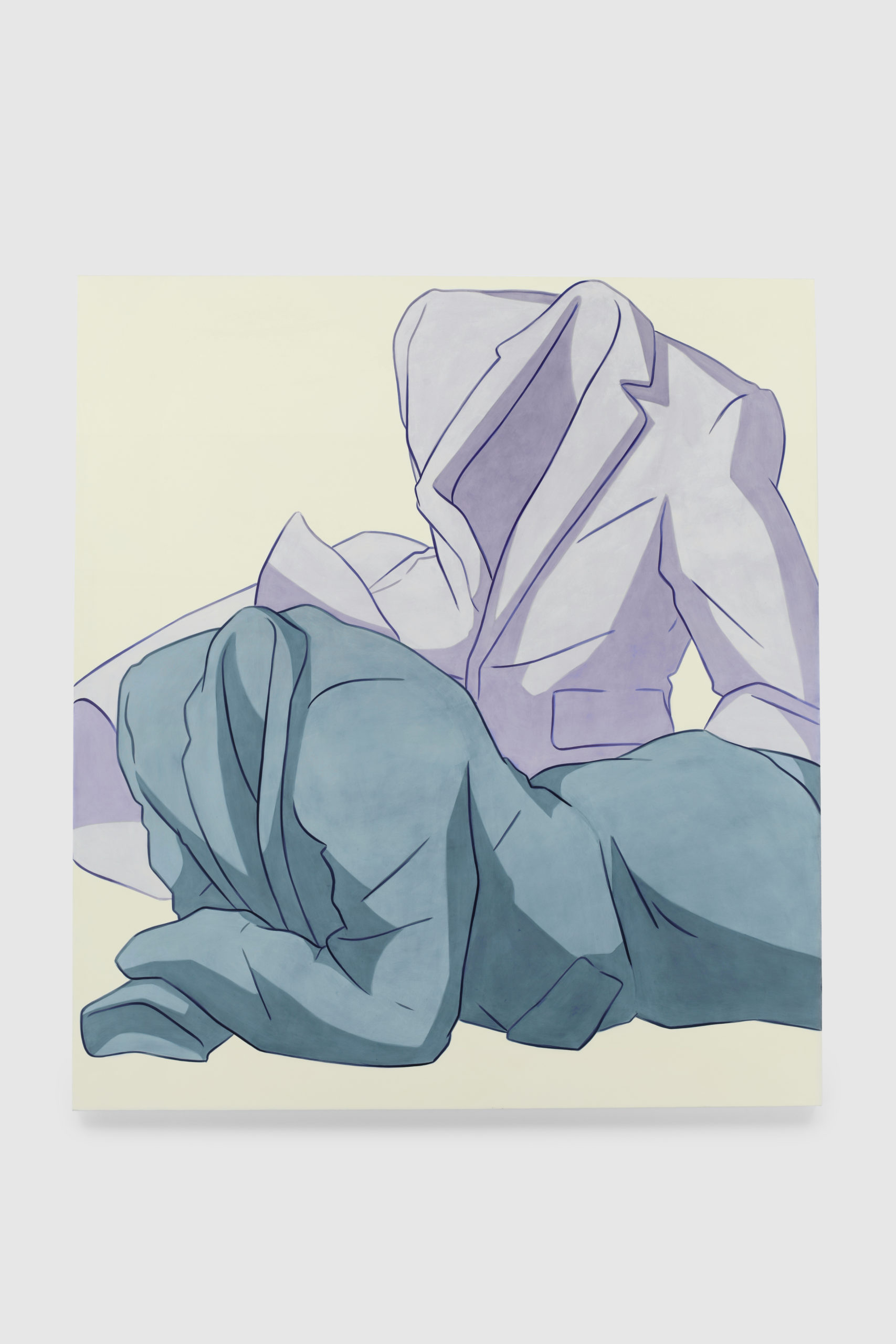Consider the Hot Dog: Ivy Haldeman on an American Icon
Ivy Haldeman, Twice, Fingertips to Forehead, Right Index Point, Counter Hand Pivot, 2021, Acrylic on canvas, 83.5 x 57.5 in [photo: Phoebe d’Heurle; courtesy of the artist and Downs & Ross, New York]
Share:
“They don’t waste anything here,” said the guide, and then he laughed and added a witticism, which he was pleased that his unsophisticated friends should take to be his own: “they use everything about the hog except the squeal.”
– Upton Sinclair, The Jungle (1906)
Consider the hot dog. Just for a moment.
Do you think of vendors at the entrance to Central Park, baseball games, or Nathan’s Famous hot dogs? Does the Fourth of July make you want a hot dog real bad? Perhaps you conjure an image of Oscar Mayer wieners tucked away in their vacuum-sealed packaging or a suburban dad grilling at a pool party. It’s possible that you jump straight to the Roy Lichtenstein and Claes Oldenburg hot dogs, in all their Pop Art poignancy. Maybe, like me, you didn’t realize how much and how little you thought about hot dogs until you encountered the work of Ivy Haldeman.
Ivy Haldeman, Twice Colossus, Head Leans Left, Pinky Up, Head Leans Right (Gaze), 2021, Acrylic on canvas, 83.5 x 57.5 inches [photo: Phoebe d’Heurle; courtesy of the artist and Downs & Ross, New York]
Haldeman paints anthropomorphic hot dogs and power suits. Her hot dogs can be found in various states of leisure: luxuriating on pillowy buns, daydreaming, fiddling with their high-heeled shoes, flipping the pages of a book, stretching, talking on a banana phone. They are deeply feminine; the hot dog embodies the prescribed body language—fluttering eyelashes, sultry hip-movements—that one associates with a femme fatale. Meanwhile, Haldeman’s power suits live in pairs. They are empty but alive, a little more active than their hot dog counterparts; the suits look like they’re consulting on a private matter. The paintings are monumental in scale, nearing the size of a state portrait or a dramatic landscape. And yes, the premise would be ridiculous—if the paintings weren’t so thoughtful, luminous, and precise. Haldeman’s paintings capture the way quotidian images inform how we fashion ourselves, how we move about the world. They ask, “How do we wear ourselves into becoming ourselves? And what do things, such as inanimate objects and advertisements, demand from us?
When I visit her studio on a blustery September day, Haldeman tells me her avatar’s origin story. When traveling in Buenos Aires, she came across the image of a stilettoed hot dog on the side of a building, in an advertisement for a deli. Initially, she says, “I was like, ‘Oh, this is funny,’ and I did the sketch, and then I put it away.” But a few years later, she found the sketch, “and there was that shift: ‘Oh, this is not funny. I relate to this way too much.’” It is in this reconciliation, from funny to not funny, that her paintings’ seriousness becomes striking. In her work, Haldeman takes objects that are traditionally phallic (the hot dog) and masculine (the business suit), and by way of body language, color palette, and accessories, renders them feminine.[1] Her works propose that the visual conventions around womanhood can be add-ons or responses to a masculine norm. And within the worlds of her canvases, Haldeman expresses how utopian thinking and exploitation, far from being at opposite ends of a spectrum, often work hand in hand.
Haldeman explains, “When I started on this journey, and I was on this idea of the feminized hot dog, I was trying to figure out, what’s in the images? … It wasn’t about the changeability of objects, like I’m shopping for things to put in the painting. But what could I have in it that would give narrative context?” She landed on the original high-heeled shoes—“when the hot dog figure is walking flat-footed, something very important is missing”—the teeny topknot, and the bun. The buns are the fluffy, eggy, enviable kind you see in the windows of Korean bakeries. Based on how she paints them, the buns take on different personalities, becoming everything from a fur coat to a bed.
On one level, this bun variety allows Haldeman ample chances for “artistic flexes,” but on another, it affords her hot dog an opportunity many of us don’t get often enough: to rest. Haldeman references a cartoon by Liana Finck, in which the subject “walks into the house, and every object she sees there is like ‘Brush me!’ ‘Hang me up!’ ‘Fold me!’” In her utopian hot-dog world, objects don’t demand anything of their owner, but exist for their owner’s pleasure and use. The space, which is white, minimalist, and clutter-free, is what Okakura Kakuzō might call “a sanctuary from the vexations of the outer world.”[2] Haldeman, who doesn’t even have a couch in her studio, remembers feeling sleepy and thinking, “I’m so tired, but I can’t nap. You know who can nap?”
Ivy Haldeman, Full Figure, Finger to Eye, Hand on Opposite Thigh, Foot Behind Bottom, 2021, Acrylic on canvas, 83.5 x 57.5 inches [photo: Phoebe d’Heurle; courtesy of the artist and Downs & Ross, New York]
At this point, Haldeman pulls out a book about Kitagawa Utamaro, one of the renowned ukiyo-e printmakers from Edo-period Japan. Like Haldeman’s paintings, Utamaro’s works are marked by a fascination with the human figure and with how subtle shifts in movement can convey narrative. In Utamaro’s case, he was mostly creating “pictures of the floating world,” the classic depictions of Japan’s pleasure districts. Haldeman shows me a series of prints with women in candid positions, seemingly unaware of anyone’s gaze. Utamaro catches a woman smoking, making an informal gesture, partially undressed, or emerging from bed. The allure of Utamaro’s works exists in these details and their seeming humanism, the voyeuristic pleasure of peering through a lit window on a darkened street.
Crucially, these women are not relaxing or having a private moment; they are laborers. In addition to being courtesans of the pleasure district—coming from lower classes, risking venereal diseases—the women are being depicted in what are outright advertisements. Haldeman points out a branded sake cup in the corner of one image. Centuries after Utamaro, Kazuo Ishiguro described the patriarchal qualities of these artworks by way of an unreliable narrator: “the finest, most fragile beauty an artist can hope to capture drifts within those pleasure houses after dark.”[3] Those moments, illusory and ephemeral, are tailored to the men who profit from or partake of women’s labor. The women, beautiful as they are, relaxed as they seem, are tainted by the male gaze.
Likewise, Haldeman’s hot dogs may rest, clutter- and vexation-free, but they’re still working. The hot dog figures carry themselves flirtatiously, erotically, recalling their mass-marketed cousins, the Chiquita Banana or the green M&M. (This brings up the troubling idea that feminizing/sexualizing food will make us want to buy more of it. Are we meant to relate to the food? Desire it?) Haldeman sums up the problem: “You are working. Your image is working. How many layers of yourself can we use to extract capital?”
Ivy Haldeman, Twice, Fingertips to Forehead, Right Index Point, Counter Hand Pivot, 2021, Acrylic on canvas, 83.5 x 57.5 inches [photo: Phoebe d’Heurle; courtesy of the artist and Downs & Ross, New York]
Haldeman’s query almost directly parallels a passage in Upton Sinclair’s 1906 novel The Jungle, wherein a meatpacking factory is described as using “everything about the hog except the squeal.”[4] The text, which famously depicts the horrifying working conditions of Chicago’s meatpacking industry (and led to national reforms, including the 1906 Meat Inspection Act), follows a Lithuanian family who moves to the United States in search of a better life. Initially, the family is impressed by the efficiency and technology of the meatpacking plants. They slowly, then very quickly, realize that they have been swindled by the American myth, as they lose jobs, fall into debt, and die from a huge variety of preventable causes. The Jungle, written more than a century ago, deals with the total exhaustion, confusion, and corruption of working in America—and with meat. Like Haldeman’s hot dogs, Sinclair’s animals foreshadow the way his characters will be burnt out and replaced. He writes, “In these chutes the stream of animals was continuous; it was quite uncanny to watch them, pressing on to their fate, all unsuspicious—a very river of death. Our friends were not poetical, and the sight suggested to them no metaphors of human destiny ….”[5] Haldeman and I both recall learning about the book in high school, and as Haldeman summarizes, we were taught “the main takeaway was government regulation, but the book ends with a literal communist sermon.”
If Haldeman’s hot dogs, Utamaro’s courtesans, and Sinclair’s characters are somewhat naïve to the layers and pitfalls of labor, Haldeman’s suits understand the game. “Maybe that became like an ironic twist of making the suits. These suits know that they’re working,” Haldeman explains. Her suits are of a 1980s variety, when broad shoulders and masculine silhouettes were adopted by women in an effort to co-opt the sartorial language of power (thereby eschewing any notion of feminine sartorial power). She saw a drawing of a similar suit and knew immediately from the “little tiny cock in her hip … how conflicted this woman was. All I needed to see was that suit to feel the ambition, misgivings, and overwork.”
Ivy Haldeman, Two Suits, Face to Face, Cuff Grasped (Smalt, Red), 2021, Acrylic on canvas, 67.75 x 60.25 in [photo: Phoebe d’Heurle; courtesy of the artist and Downs & Ross, New York]
As with the hot dogs, the suits are quotidian images that are—whether we are conscious of it or not—important to how we construct ourselves. Haldeman thinks back to her childhood self, when “I thought that putting on a suit was how you journeyed through the world.” Although many adults don’t wear suits now, they often dress in relation to our consciousness of them and of where a suit falls in a specific industry’s hierarchy. Haldeman brings up art fairs, where there is often a contingent of gallerists in blue suits, and in that flock, “a very young man wearing what feels like their first suit. And then you’re like, ‘Oh, they’re wearing the child’s idea of the suit,’ and it will change continuously. As he moves in his career, he will wear very different suits.”
Haldeman’s suits always travel in pairs, gussied up in complimentary pastels. There is a note of camaraderie between them; they’re touching and quite literally supporting each other. For Haldeman, the two suits, in tandem, seem to resemble a face. But they also evoke the idea that “you don’t wear a suit for yourself, you wear a suit to be in a group of people. I like this idea of operating like a single entity even though you’re multiple bodies.” Even if the suits travel only in pairs, they inherently suggest the existence of a larger system—more suits than can be contained on Haldeman’s studio walls.
Haldeman’s suits are full of body and meaning, but they are empty. Dress historian Juliet Ash theorizes that, in contemporary art, where empty clothes have appeared, they tend to represent “either a language of commodification … or, alternatively, the painting of clothes as emotional representations of the absence of the human form, the human body that once inhabited them.”[6]
But Haldeman’s suits seem to represent another possibility: that there is no need for the human body at all. The suits, like the hot dogs, seem to contain endless possibilities for communicating personality, motives, and livelihood. The suits and their group identity represent what Haldeman explains is the “totally unnatural” experience of living in a city, wherein the “whole body becomes the mechanism of the community.”
Midway through The Jungle, there is a vivid scene in which Sinclair describes the sausage room. On one side of the room, men “shoveled loads of meat and wheelbarrows full of spices; in these great bowls were whirling knives that made two thousand revolutions a minute, and when the meat was ground fine and adulterated with potato flour, and well mixed with water, it was forced to the stuffing machines on the other side of the room.” Women tended these machines, where they would twist a long string of “casing” over the nozzle, transforming the outflow into separate links. “This string would be twenty or thirty feet long, but the woman would have it all on in a jiffy; and when she had several on, she would press a lever, and a stream of sausage meat would be shot out, taking the casing with it as it came.”[7] Sinclair exposes the strange and mechanized world, in which men and women should be exploited and employed in the production of this vaguely carcinogenic food at an astonishing pace. Sinclair also outlines a distinctly American assemblage: that a German food can be appropriated or accepted (depending on how you look at it) to such an extent as to become associated with American patriotism and recreation. Haldeman can find a hot dog in Buenos Aires and see herself in it. The ornaments of femininity can’t be looked at straight-on but need an avatar. All of this is tied up in immigration, capitalism, and labor—and the corresponding images.[8]
Ivy Haldeman, Two Suits, Cuffs Crossed, Leaning on Elbows, Sitting with Arm Back (Smalt, Blue Horizontal), 2021, Acrylic on canvas, 67.75 x 60.25 in [photo: Phoebe d’Heurle; courtesy of the artist and Downs & Ross, New York]
In the midst of describing past studio visits, Haldeman pauses: “What is it about the shell that you’re enclosed in?” Haldeman’s works describe aesthetics as a multifarious experience: how we shape ourselves through a combination of who we feel ourselves to be, how we are seen by others, and how both exist in relation to our specific context. Feminine ideals—which are created, arbitrated, and continually revised by patriarchy—mix in with expressions of individualism and agency. Clothes are a human casing, smoothing out the relationship between our selves and our social roles. Maybe we’re all hot dogs, relying on empty suits. Consider it. It’s a little funny, no?
[1] Many thanks to Micaela Houtkin for thinking through this point (and others) with me.
[2] Okakura Kakuzō, The Book of Tea (Penguin Classics, 2016), 67.
[3] Kazuo Ishiguro, An Artist of the Floating World (Vintage Books, 1986), 150.
[4] Upton Sinclair, The Jungle (Ægypan Press, text from 1906 edition), 34.
[5] Ibid. 34.
[6] Juliet Ash, “The Aesthetics of Absence: Clothes Without People in Paintings,” in Defining Dress: Dress as Object, Meaning, and Identity (Manchester University Press, 1999), 128.
[7] Upton Sinclair, The Jungle, 121.
[8] During our conversation, Haldeman also brought up Karen Tei Yamashita’s Tropic of Orange (1997), which decenters the Eurocentric narratives about the US.
Sarah Bochicchio is a New York-based writer, editor, and researcher focused on the intersection of art, fashion, history, and gender. She recently worked at The Metropolitan Museum of Art as the research assistant on the upcoming exhibition The Tudors: Art and Majesty in Renaissance England and has contributed to numerous publications including Artsy, Vestoj, Garag
